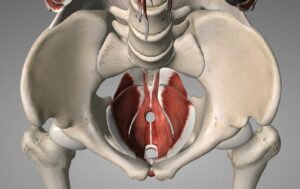One in three women will experience pelvic floor dysfunction at some point in their lives. For men, the number is one in six. Pelvic floor dysfunction can cause a wide variety of symptoms, including urinary incontinence, constipation, and pain during sex. In this blog post, we will discuss the causes, symptoms, and treatments for pelvic floor dysfunction in males. We will also provide tips for preventing pelvic floor dysfunction.
Contents
- 1 What Is Pelvic Floor Dysfunction?
- 2 How Does Pelvic Floor Dysfunction In Males Feel Like?
- 3 What Causes Male Pelvic Floor Dysfunction?
- 4 How Common Is Pelvic Floor Dysfunction In Males?
- 5 How Is It diagnosed?
- 6 How Do Men Fix Their Pelvic Floor?
- 7 Can Pelvic Floor Dysfunction Be Prevented In Males?
- 8 Conclusion
What Is Pelvic Floor Dysfunction?
 Pelvic floor dysfunction is a general term used to describe any condition that affects the functioning of the pelvic floor muscles. These muscles support the pelvic organs, including the bladder and uterus in women, and help control bowel movements. Pelvic floor dysfunction in males is also known as pelvic floor disorder.
Pelvic floor dysfunction is a general term used to describe any condition that affects the functioning of the pelvic floor muscles. These muscles support the pelvic organs, including the bladder and uterus in women, and help control bowel movements. Pelvic floor dysfunction in males is also known as pelvic floor disorder.
It is believed that this condition is not just limited to the pelvic region and can also affect the muscles of the hips, lower back, and abdomen. And males can also be affected by pelvic floor dysfunction, although this is less common. However, the exact prevalence of pelvic floor dysfunction is not known as many people do not seek medical help for this condition.
Therefore, if you are struggling or want to know more about this condition, you should not hesitate to talk to your doctor. With the right information and resources around you, living with pelvic floor dysfunction does not have to be a daunting task.
How Does Pelvic Floor Dysfunction In Males Feel Like?
Generally, this condition is often asymptomatic. When there are symptoms, they may include:
- Pain in the lower abdomen or groin
- Painful or difficult urination
- Painful ejaculation
- Blood in the urine
- Difficulty starting or maintaining a stream of urine
- Urinary incontinence
- Fecal incontinence
- Constipation
- Pain during bowel movements
These symptoms are often aggravated by activities like sex, cycling, or running. It is important to identify this condition if you experience any of these symptoms, as they can significantly impact your quality of life.
Therefore, if you have any of the above symptoms, you should consult with a doctor to get a proper diagnosis. Because this might be a sign of other more serious conditions, such as prostate cancer.
What Causes Male Pelvic Floor Dysfunction?
The causes of pelvic floor dysfunction in males can be divided into three broad categories: anatomic, functional, and structural. Let’s discuss both in more detail.
Anatomic Causes
 The most common anatomic cause of pelvic floor dysfunction in males is an injury to the pelvic floor muscles, ligaments, or fascia. This can occur as a result of trauma, such as from a car accident or fall. It can also occur due to surgery in the pelvic region, such as a prostatectomy.
The most common anatomic cause of pelvic floor dysfunction in males is an injury to the pelvic floor muscles, ligaments, or fascia. This can occur as a result of trauma, such as from a car accident or fall. It can also occur due to surgery in the pelvic region, such as a prostatectomy.
Other anatomic causes of pelvic floor dysfunction include:
- Congenital defects
- Pelvic organ prolapse
- Tumors
It is often believed that anatomical abnormalities are the primary cause of pelvic floor dysfunction in males. However, functional causes are actually more common.
Functional Causes
The most common functional cause of pelvic floor dysfunction in males is weak pelvic floor muscles. These muscles can become weak due to a sedentary lifestyle, poor diet, and lack of exercise. Other causes of weak pelvic floor muscles include:
- Aging
- Chronic constipation or diarrhea
- Obesity
- Pelvic surgery
Many people often feel like they need to “push” when they urinate or have a bowel movement. This is because the pelvic floor muscles are not strong enough to hold in urine or stool. When these muscles are weak, they can also cause other problems.
Structural Causes
In some cases, pelvic floor dysfunction may be caused by structural problems. These can include:
- Enlarged prostate
- Prostate cancer
- Testicular cancer
- Rectal prolapse
- Pelvic fractures
- Spinal cord injuries
However, these causes are relatively rare. Still, if you have any of these conditions, getting treatment for them is important, as they can cause other health problems.
So, you can see the causes of pelvic floor dysfunction are many and varied. If you think you may have this problem, it’s important to see a doctor so they can properly diagnose and treat you.
How Common Is Pelvic Floor Dysfunction In Males?
It’s estimated that about one in six men will experience pelvic floor dysfunction at some point in their lives. While it’s more common in older men, it can happen at any age. The reason behind the prevalence is largely unknown, but there are some risk factors that can increase your chances of developing the condition.
There are several theories that attempt to explain why the pelvic floor weakens with age. One is that as we get older, our bodies produce less of the hormones that are responsible for muscle growth and maintenance. Another theory is that the pelvic floor muscles simply don’t get used as much as they used to.
In other words, we don’t squat, lift, or strain as much as we used to. This lack of use can lead to muscle atrophy, which is when the muscles waste away. Therefore, pelvic floor dysfunction in males is common due to a combination of factors that come with age.
How Is It diagnosed?
Pelvic floor dysfunction is diagnosed through a combination of a thorough medical history and physical examination. Your doctor will ask questions about your symptoms, bowel habits, and urinary function. A rectal exam may also be performed to assess the tone and strength of the muscles in your pelvic floor.
In some cases, additional tests may be ordered to help confirm the diagnosis. These tests may include:
- Anorectal manometry: This test measures the pressure in the anal canal and rectum.
- Pelvic floor EMG: This test assesses the electrical activity of the muscles in your pelvic floor.
- Pelvic ultrasonography: This test uses sound waves to create an image of the pelvic organs and muscles.
It is important to note that pelvic floor dysfunction can often be confused with other conditions, such as irritable bowel syndrome or overactive bladder. Therefore, it is important to seek the help of a healthcare professional if you are experiencing any symptoms that are causing you discomfort.
How Do Men Fix Their Pelvic Floor?
 Pelvic floor dysfunction can happen to anyone, but it’s especially common in men. That’s because the pelvic floor muscles support not only the bladder and bowel but also the penis and testicles. When these muscles are weak or damaged, it can lead to several problems. Here are some options that can help:
Pelvic floor dysfunction can happen to anyone, but it’s especially common in men. That’s because the pelvic floor muscles support not only the bladder and bowel but also the penis and testicles. When these muscles are weak or damaged, it can lead to several problems. Here are some options that can help:
Kegel exercises
These exercises strengthen the pelvic floor muscles. To do them, squeeze the muscles you would use to stop the flow of urine. Hold for a count of three, then relax for a count of three. Repeat 10 to 15 times. There are several types of Kegel devices that can help make doing the exercises easier. Also, the types of exercises can be found online and in many health books.
Biofeedback
This treatment uses sensors placed on the skin to help you learn to contract and relax the pelvic floor muscles. The sensors are connected to a machine that shows how well the muscles are working. For example, the machine may make a sound when the muscles contract. Biofeedback may help you learn to control your pelvic floor muscles and improve your symptoms. This treatment is usually done by a physical therapist.
Electrical stimulation
For this treatment, electrodes are placed on the skin over the muscles of the pelvic floor. A small machine sends electrical impulses to the electrodes. The goal is to help the muscles relax and contract. This can help with both urinary and fecal incontinence, as well as sexual function. The aim of this stimulation is to reduce the number of involuntary contractions of the pelvic floor muscles.
Botulinum toxin injections
Botulinum toxin is a protein that is produced by the bacterium Clostridium botulinum. This toxin can cause a form of food poisoning known as botulism. However, when used in small doses, botulinum toxin can be an effective treatment for a variety of medical conditions, including pelvic floor dysfunction. Botulinum toxin works by temporarily paralyzing the muscles that are causing the symptoms of pelvic floor dysfunction.
Surgery
 In some cases, surgery may be needed to release tightness in the pelvic floor muscles or to remove scar tissue. The surgery is often done as day surgery, which means you can go home the same day. And the process might be done through a small cut (incision) in the area between the anus and scrotum (perineum).
In some cases, surgery may be needed to release tightness in the pelvic floor muscles or to remove scar tissue. The surgery is often done as day surgery, which means you can go home the same day. And the process might be done through a small cut (incision) in the area between the anus and scrotum (perineum).
If you have pelvic floor dysfunction, your doctor might suggest one of these types of surgery:
- A perineal incision to release tightness in the pelvic floor muscles
- A transurethral incision releases scar tissue that’s blocking urine flow
- A suprapubic incision to remove an obstruction in the urinary tract
After any of these procedures, you might need to stay in the hospital for a night or two. And you’ll likely need to take it easy at home for a week or two.
So, you can see these are some treatment options that you might consider for your pelvic floor dysfunction. Also, do not hesitate to ask your doctor about other possible treatments, as well. Pelvic floor dysfunction is a common condition, but there is no need to suffer from it. There are many effective treatments available. Work with your doctor to find the best one for you.
Can Pelvic Floor Dysfunction Be Prevented In Males?
It’s not always possible to prevent pelvic floor dysfunction. However, you may be able to reduce your risk of developing the condition by:
- Exercising regularly
- Eating a healthy diet
- Maintaining a healthy weight
- Avoiding smoking
- Practicing good posture and lifting techniques
These things will help to keep your pelvic floor muscles strong and healthy. If you have a family history of pelvic floor dysfunction, you may be more likely to develop the condition. But there’s no way to prevent it completely.
With the right treatment, most men with pelvic floor dysfunction can find relief from their symptoms. If you’re struggling with the condition, talk to your doctor about the best treatment options for you.
Conclusion
In conclusion, pelvic floor dysfunction in males can have a significant impact on quality of life. It is important to be aware of the symptoms and seek treatment if necessary. With proper diagnosis and treatment, many men can find relief from their pelvic floor dysfunction.
A pelvic floor is a group of muscles, ligaments, and connective tissue that supports the bladder, uterus, and rectum. Physical therapy can help strengthen the pelvic floor muscles. However, in some cases, surgery may be necessary to correct the problem.
All in all, Physical Therapy helps patients recover from pain. If you’re experiencing Back pain, Shoulder pain, Knee pain, Neck pain, Elbow pain, Hip pain, or Arthritis pain, a physical therapist at MantraCare can help: Book a physiotherapy session.


